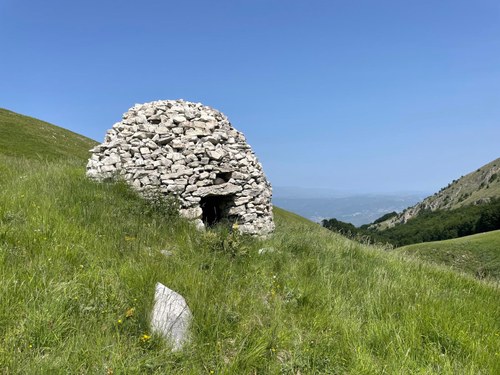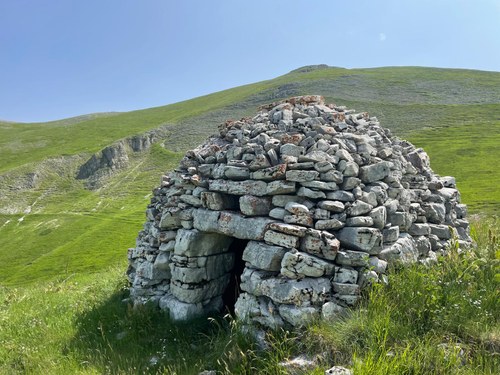The 'caciare' huts of Montagna dei Fiori
Archaeology of an upland landscape

The caciare, the typical dry-stone huts, have been part of the collective memory of people from Ascoli for generations. If you hike up from Colle San Marco towards the Monti Gemelli, between Ascoli and Teramo, you’ll still come across these little stone structures, often half-hidden by vegetation but always there to tell the story of the area.
Over the years, various local and national groups have carried out surveys and published their findings, some in detailed reports, others in more popular formats. But up to now, there’s never been a complete map of these structures, nor an in-depth study of what they were used for, what condition they’re in, or how they could be valued and promoted locally or even nationally.
That’s why the new collaboration between the University of Bologna team led by Enrico Giorgi and the officials from the Archaeology and Heritage Authority (for the provinces of Ascoli Piceno, Fermo, and Macerata) coordinated by Giovanni Issini is so important. They’ve kicked off the first digital mapping of the caciare, aiming to get a full picture of how widespread they are and how well they’re preserved.

Even on the very first field trip, in June 2025, they managed to map 50 caciare in the municipalities of Ascoli Piceno and Valle Castellana. Plus, by looking at satellite images, such as the ones available on Google Earth, it’s clear there are plenty more, including in nearby towns like Civitella del Tronto. Unfortunately, most of these structures are now just ruins or hidden by overgrowth. A few still standing might have been rebuilt fairly recently thanks to the interest of local associations, like the CAI, and enthusiasts keen to keep this heritage alive.
Despite that, some of the best-preserved and most accessible ones — like the famous Tre Caciare of Montagna dei Fiori, the hut near San Giacomo, and the one on the eastern slope of Monte Piselli — have already been documented in detail. During these surveys, they also spotted dry-stone walls, depressions in the ground that could be old snow pits or ponds, and even some cropmarks hinting at more hidden features.

Going forward, the project will keep involving Archaeology students from the University of Bologna, especially those who actually come from this area, along with professional archaeologists working in Ascoli and the province. And just as important will be getting the local community and schools involved, to build awareness of how unique and valuable these structures are for the Ascoli area.
The project results will be shared not just online on this website, but also through events and public meetings organised together with the institutions involved, so that everyone can discover and take pride in this incredible heritage.